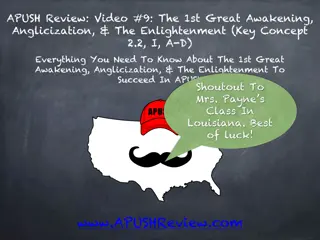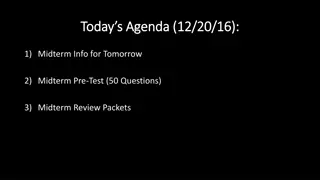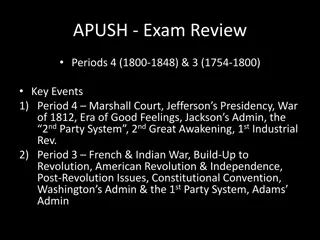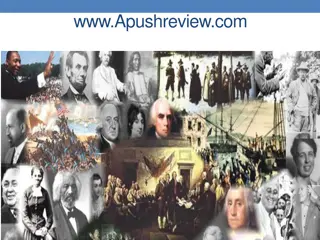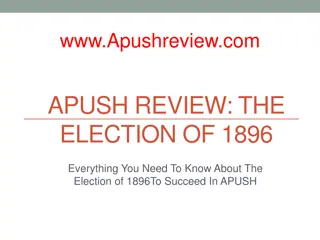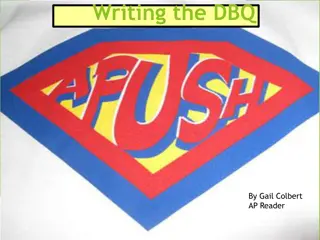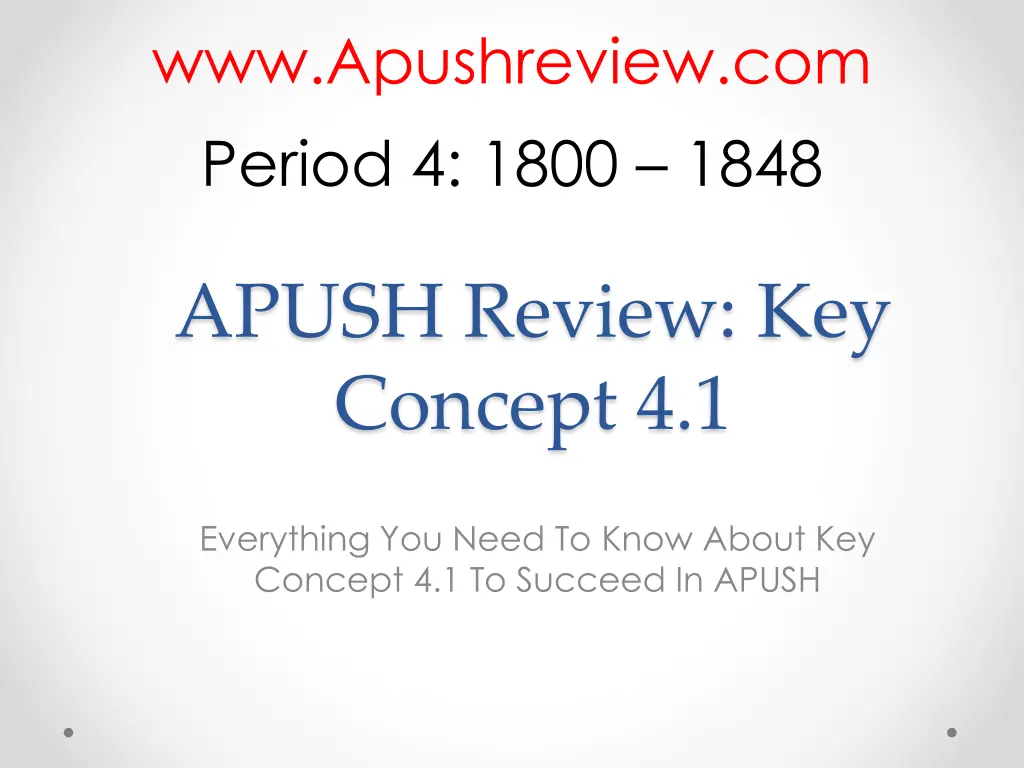
United States Transformation to Modern Democracy - Key Concept 4.1 Overview
Explore the development of modern democracy in the United States from 1800 to 1848 through Key Concept 4.1. Discover how federal-state relations evolved, reform movements reshaped society, and slaves forged new cultures. Dive into debates over federal power, political parties, Supreme Court rulings, economic policies, and regional loyalties during this transformative period in American history.
Download Presentation

Please find below an Image/Link to download the presentation.
The content on the website is provided AS IS for your information and personal use only. It may not be sold, licensed, or shared on other websites without obtaining consent from the author. If you encounter any issues during the download, it is possible that the publisher has removed the file from their server.
You are allowed to download the files provided on this website for personal or commercial use, subject to the condition that they are used lawfully. All files are the property of their respective owners.
The content on the website is provided AS IS for your information and personal use only. It may not be sold, licensed, or shared on other websites without obtaining consent from the author.
E N D
Presentation Transcript
www.Apushreview.com Period 4: 1800 1848 APUSH Review: Key Concept 4.1 Everything You Need To Know About Key Concept 4.1 To Succeed In APUSH
The New Curriculum Key Concept 4.1 The United States developed the world s first modern mass democracy and celebrated a new national culture, while Americans sought to define the nation s democratic ideals and to reform its institutions to match them. o Page 38 of the Curriculum Framework Big ideas: o How did the relationship between the federal and state governments change during this time? o How did various reform movements change society? o How did slaves adapt to their circumstances and create a new culture?
Key Concept 4.1 I The nation s transformation to a more participatory democracy was accompanied by continued debates over federal power, the relationship between the federal government and the states, the authority of different branches of the federal government, and the rights and responsibilities of individual citizens. page 38 of the curriculum framework Development of the 1st and 2nd Political Party System: o Federalists: favored stronger central government, supported by upper-class, merchants and bankers, and Pro-British, loose interpretation of the Constitution o Democratic-Republicans: states-rights, supporter by lower and middle classes, farmers, Pro-French, strict interpretation of the Constitution Both parties developed out of Hamilton s Financial Plan and the French Revolution o 2nd Political Party System: Democrats: Led by Andrew Jackson, the Common Man : against BUS and other Elite organizations Whigs: Anti-Andrew Jackson; favored stronger federal government, internal improvements, BUS The Supreme Court strengthened the power of the federal government, often at the expense of state governments: o Marbury v. Madison established the principle of judicial review o McCulloch v. Maryland upheld constitutionality of 2nd BUS, federal government given more power of states o Gibbons v. Ogden Congress, NOT states can control interstate commerce
Key Concept 4.1 I Cont. With a growing economy, Americans debated the role of government in the economy: o Hartford Convention New England delegates were upset with embargos and War of 1812 (cut off trade to Britain major trading partner); proposed several amendments including tougher restrictions for declaring war and passing embargos o Internal improvements debates over the role of federal government in intrastate improvements Mayesville Road veto (1830) Jackson vetoed a bill for the road which would only be in KY Regional political and economic loyalties overshadowed national concerns: Nullification Crisis (1833) South Carolina and other southern states opposed the Tariffs of 1828 and 1832; South Carolina even nullified those tariffs South Carolina threatened to secede if Jackson collected the tariff by force Webster s 2nd Reply to Hayne Webster promoted nationalism over sectionalism Why did many whites in the South associate their regional identity through pride in slavery? o Wealthy whites saw themselves as aristocrats; owning slaves was a symbol of wealth o Many poor whites favored slavery since they (poor whites) were higher on the social order in society
Key Concept 4.1 II Concurrent with an increasing international exchange of goods and ideas, larger numbers of Americans began struggling with how to match democratic political ideals to political institutions and social realities. page 39 of the curriculum framework The 2nd G.A. and social ideas from abroad helped inspire humans to achieve perfection: o Charles G. Finney massive sermons to convert individuals o Seneca Falls (1848) women s rights convention in NY - Elizabeth Cady Stanton and Lucretia Mott o Utopian Societies social experiments that hoped to achieve perfection in communities Oneidas, Brooke Farm, etc. African Americans citizenship possibilities continued to be restricted even though: o International slave trade was outlawed in 1808 o An increasing number of free African Americans in the North AND the South: Eventually, many states made it illegal for slave owner to manumit (free) their slaves o Discussions of emancipation plans: William Lloyd Garrison, The Liberator called for the immediate and uncompensated end to slavery American Colonization Society advocated free slaves be sent to Africa
Key Concept 4.1 II Cont. Resistance to initiatives for democracy: o Proslavery arguments: increased drastically after Nat Turner s Rebellion (1831) John C. Calhoun s Slavery as a Positive Good argued that slaves worked under better conditions than industrial workers in the North Some advocates used the bible to justify slavery George Fitzhugh used similar arguments o Xenophobia: Fear of foreigners (Nativism pro Native-born Americans and hostility to foreign-born individuals) o Immigrants were accused of stealing jobs by working for less money Irish were heavily discriminated against belief that they stole elections Know-Nothing Party (American Party) hoped to pass immigration restriction laws; became a powerful political party in the 1850s o Similar to the American Protective Association of late 19th century o Anti-black sentiments in political and popular culture: Minstrel Shows variety shows using blackface o Restrictive anti-Indian policies: Indian Removal Act (1830) required Native tribes in Georgia to move west of the Mississippi River, Jackson ignored the Supreme Court s ruling in Worcester v. Georgia and Native Americans were forced to move -> Trail of Tears
Key Concept 4.1 III While Americans celebrated their nation s progress toward a unified new national culture that blended Old World forms with New World ideas, various groups of the nation s inhabitants developed distinctive cultures of their own. page 39 of the curriculum framework The emergence of a new national culture o Was a combination of European and local culture o New American Art, literature, and architectural ideas emerged Examples: John James Audubon made significant contributions to the study of birds prints of birds The Hudson River School focused on landscape paintings; believed nature was a great source of wisdom and inspiration Cultures developed based on interests and experiences of specific groups o American Indians: throughout most of the early 19th century, Indians were relocated further and further west Indian Removal Act In the 1840s, the reservation developed as a way living for Indians o Women: more women began to attend higher education Cult of Domesticity Seneca Falls Convention 1848 o Declaration of Sentiments
Key Concept 4.1 III Cont. Cultures developed based on interests and experiences of specific groups (Continued) o Religious followers: Shakers and Mormons Shakers: practiced celibacy,; believed in sexual equality Mormons: after years of turbulence, they moved to Utah where they could freely practice their religion o Urban middle class: more and more Americans were owning shops and businesses, and became professionals Lived in large houses that they owned Bought new inventions cast-iron stove Enslaved African Americans created communities and sought to protect their family structures and dignity o African Americans developed surrogate families o When families were separated via slavery, others would look after family members o Slave music used to help pass the time while working Instrumental part of religious services Others played important roles in the abolitionist and reform movements and sought to change their status: o Example: David Walker An Appeal to Colored Citizens of the World (1829) Sought for African Americans to openly resist their oppression Two years later, Nat Turner s Rebellion occurred (1831), which helped strengthen the desire to silence abolitionism in the South
Test Tips Multiple-Choice and Short Answer Questions: o Native American interactions under the New Nation o Reasons for the development of political parties o Republican Motherhood how were women viewed? Essay Questions: o Issues that led to the creation of political parties o Impact of the 2nd Great Awakening on American society
Thanks for watching! Subscribe to my channel Help spread the word Questions? Comments? o Leave in comments




